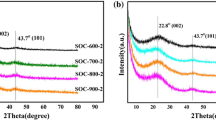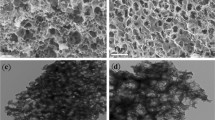Abstract
Boron-doped carbon nanostructures were obtained via template and bulk synthesis from sucrose in the presence of boric acid. Synthesized B-containing mesoporous materials are characterized by high spatial ordering, developed surface (up to 870 m2/g), and porosity (up to 1.2 cm3/g). The obtained B-doped microporous materials exhibit high interfacial capacitance (up to 0.36 F/m2), which is higher than the available literature data and enables the use of synthesized samples as materials of supercapacitors. The capacity of electric double layer up to 300 F/g using sulfuric acid as the electrolyte was accumulated on microporous B-doped carbons.






Similar content being viewed by others
References
Stein A, Wang Z, Fierke MA (2009) Functionalization of porous carbon materials with designed pore architecture. Adv Mater 21:265–293
Xia Y, Yang Z, Zhu Y (2013) Porous carbon-based materials for hydrogen storage: advancement and challenges. J Mater Chem A 1:9365–9381
Burgess JS, Acharya CK, Lizarazo J, Yancey N, Flowers B, Kwon G, Klein T, Weaver M, Lane AM, Turner CH, Street S (2008) Boron-doped carbon powders formed at 1000 °C and one atmosphere. Carbon 46:1711–1717
Jeong Y, Chung TCM (2010) The synthesis and characterization of a super-activated carbon containing substitutional boron (BC x ) and its applications in hydrogen storage. Carbon 48:2526–2537
Paraknowitsch JP, Thomas A (2013) Doping carbons beyond nitrogen: an overview of advanced heteroatom doped carbons with boron, sulphur and phosphorus for energy applications. Energy Environ Sci 6:2839–2855
Wang L, Yang FH, Yang RT (2009) Hydrogen storage properties of B-and N-doped microporous carbon. AIChE J 55:1823–1833
Zhai X, Song Y, Liu J, Li P, Zhong M, Ma C, Wang H, Guo Q, Zhi L (2012) In-situ preparation of boron-doped carbons with ordered mesopores and enhanced electrochemical properties in supercapacitors. J Electrochem Soc 159:E177–E182
Arutyunyan NR, Arenal R, Obraztsova ED, Stephan O, Loiseau A, Pozharov AS, Grebenyukov VV (2012) Incorporation of boron and nitrogen in carbon nanomaterials and its influence on their structure and opto-electronical properties. Carbon 50:791–799
Wu X, Radovic LR (2004) Ab initio molecular orbital study on the electronic structures and reactivity of boron-substituted carbon. J Phys Chem A 108:9180–9187
Morita T, Takami N (2004) Characterization of oxidized boron-doped carbon fiber anodes for Li-ion batteries by analysis of heat of immersion. Electrochim Acta 49:2591–2599
Shiraishi S, Kibe M, Yokoyama T, Kurihara H, Patel N, Oya A, Kaburagi Y, Hishiyama Y (2006) Electric double layer capacitance of multi-walled carbon nanotubes and B-doping effect. Appl Phys A 82:585–591
Zhong DH, Sano H, Uchiyama Y, Kobayashi K (2000) Effect of low-level boron doping on oxidation behavior of polyimide-derived carbon films. Carbon 38:1199–1206
Niu L, Li Z, Hong W, Sun J, Wang Z, Ma L, Wang J, Yang S (2013) Pyrolytic synthesis of boron-doped graphene and its application as electrode material for supercapacitors. Electrochim Acta 108:666–673
Chen SM, Ramachandran R, Mani V, Saraswathi R (2014) Recent advancements in electrode materials for the high performance electrochemical supercapacitors: a review. Int J Electrochem Sci 9:4072–4085
Fang H, Yu C, Ma T, Qiu J (2014) Boron-doped graphene as a high-efficiency counter electrode for dye-sensitized solar cells. Chem Commun 50(25):3328–3330
Yu C, Fang H, Liu Z, Hu H, Meng X, Qiu J (2016) Chemically grafting graphene oxide to B N co-doped graphene via ionic liquid and their superior performance for triiodide reduction. Nano Energy 25:184–192
Ling Z, Wang G, Zhang M, Fan X, Yu C, Yang J, Qiu J (2015) Boric acid-mediated B N-codoped chitosan-derived porous carbons with a high surface area and greatly improved supercapacitor performance. Nanoscale 7(12):5120–5125
Ling Z, Wang Z, Zhang M, Yu C, Wang G, Dong Y, Qiu J (2016) Sustainable synthesis and assembly of biomass-derived B/N co-doped carbon nanosheets with ultrahigh aspect ratio for high-performance supercapacitors. Adv Funct Mater 26(1):111–119
He X, Ling P, Qiu J, Yu M, Zhang X, Yu C, Zheng M (2013) Efficient preparation of biomass-based mesoporous carbons for supercapacitors with both high energy density and high power density. J Power Sour 240:109–113
Wang DW, Li F, Chen ZG, Lu GQ, Cheng HM (2008) Synthesis and electrochemical property of boron-doped mesoporous carbon in supercapacitor. Chem Mater 20:7195–7200
Zhao D, Feng J, Huo Q, Melosh N, Fredrickson GH, Chmelka BF, Stucky GD (1998) Triblock copolymer syntheses of mesoporous silica with periodic 50 to 300 Angstrom pores. Science 279(5350):548–552
Dubinin MM (1965) Theory of the bulk saturation of microporous activated charcoals during adsorption of gases and vapors. Russ J Phys Chem 39:697–704
Horvath G, Kawazoe K (1983) Method for calculation of effective pore size distribution in molecular sieve carbon. J Chem Eng Jpn 16:470–475
Gregg SG, Sing KSW (1982) Adsorption Surface Area and Porosity. Academic Press, New York
Chen F, Xu XJ, Shen S, Kawi S, Hidajat K (2004) Microporosity of SBA-3 mesoporous molecular sieves. Microporus Mesoporus. Mater 75:231–235
Barrett EP, Joyner LG, Halenda PP (1951) The determination of pore volume and area distributions in porous substances. I. Computations from nitrogen isotherms. J Am Chem Soc 73:373–380
Adolphs J (2007) Excess surface work—a modelless way of getting surface energies and specific surface areas directly from sorption isotherms. Appl Surf Sci 253:5645–5649
Nemodruk AA, Karalova ZK (1965) Analytical chemistry of boron. Israel Program for Scientific Translations, Jerusalelm
Han J, Zhang LL, Lee S, Oh J, Lee KS, Potts JR, Park S (2012) Generation of B-doped graphene nanoplatelets using a solution process and their supercapacitor applications. ACS Nano 7(1):19–26
Shcherban ND, Yaremov PS, Ilyin VG, Ovcharova MV (2014) Influence of the method of activation on the structural and sorption properties of the products of carbonization of sucrose. J Anal Appl Pyrol 107:155–164
Chung TM, Jeong Y, Chen Q, Kleinhammes A, Wu Y (2008) Synthesis of microporous boron-substituted carbon (B/C) materials using polymeric precursors for hydrogen physisorption. J Am Chem Soc 130:6668–6669
Chen LF, Zhang XD, Liang HW, Kong M, Guan QF, Chen P, Wu Z-Y, Yu SH (2012) Synthesis of nitrogen-doped porous carbon nanofibers as an efficient electrode material for supercapacitors. ACS Nano 6:7092–7102
Lowell CE (1967) Solid solution of boron in graphite. J Am Ceram Soc 50:142–144
Author information
Authors and Affiliations
Corresponding author
Ethics declarations
Conflict of Interest
The authors declare that they have no conflict of interest.
Rights and permissions
About this article
Cite this article
Shcherban, N., Filonenko, S., Yaremov, P. et al. Boron-doped nanoporous carbons as promising materials for supercapacitors and hydrogen storage. J Mater Sci 52, 1523–1533 (2017). https://doi.org/10.1007/s10853-016-0447-x
Received:
Accepted:
Published:
Issue Date:
DOI: https://doi.org/10.1007/s10853-016-0447-x




